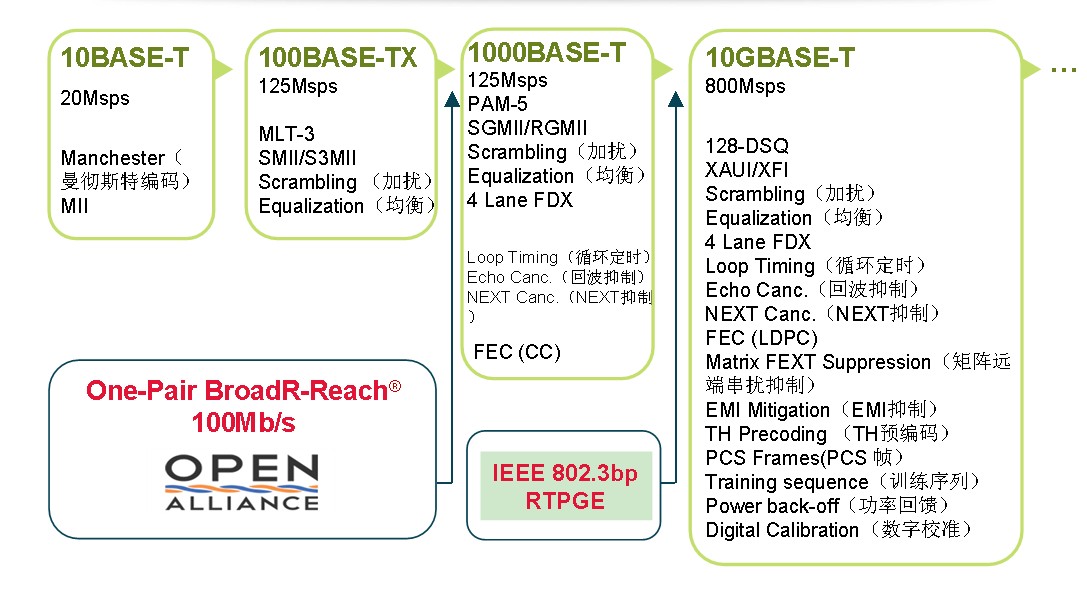Due to the significant increase in the number and complexity of in-vehicle electronic devices, the demand for low-cost, high transmission rate and high-bandwidth network solutions is on the rise. Existing automotive communication technologies, such as media-oriented system transmission (MOST) and low-voltage differential signaling (LVDS) technologies, cannot meet these needs because these technologies are not scalable and cannot support newly added services and applications. On the other hand, Ethernet-based communication technology is a cost-effective and scalable solution that can support multiple systems and devices, provide high data transmission rates, and each port has its own dedicated bandwidth. Single-pair twisted-pair vehicle-mounted Ethernet uses unshielded twisted pair (UTP) cable, and the data transmission rate can reach 100Mbps. This is a relatively new Ethernet technology that can meet the needs of vehicle networks in terms of high reliability, low electromagnetic radiation, and low power consumption. Using single-pair unshielded cables and smaller and more compact connectors can reduce connection costs by up to 80% and wiring weight by up to 30%. Unlike the 100BASE-TX half-duplex technology, single-pair twisted-pair vehicle-mounted Ethernet can achieve simultaneous transmission and reception (that is, full-duplex) operation on a single-pair twisted pair. For simplicity, single-pair twisted-pair vehicle-mounted Ethernet is hereinafter referred to as vehicle-mounted Ethernet. Compared with the scrambler used by 100BASE-TX, the onboard Ethernet digital signal processor (DSP) uses a highly optimized scrambler, which can better separate the signals and provide a powerful and efficient signal for automotive applications. Make the solution more efficient than the 100BASE-TX system. This limits the signal bandwidth of in-vehicle Ethernet to 33.3MHz, which is only half of the 100BASE-TX system. Lower signal bandwidth can improve return loss, reduce crosstalk, and ensure that automotive Ethernet meets automotive electromagnetic emission standards. Figure 1 What is BroadR-Reach® Ethernet? Figure 1 tells us what is BroadR-Reach® Ethernet. About BroadR-Reach® Ethernet, you need to pay attention to the following points: (1) The physical layer (PHY) of BroadR-Reach has been standardized by the One-Pair Ethernet Alliance (OPEN), which enables bidirectional transmission on a pair of unshielded twisted pair (UTP). (2) Physical layer of BroadR-Reach vehicle network Utilizes the mature IEEE standard BASE-T PHYs technology; supports single-pair twisted-pair wiring of the vehicle network; has a short channel to reach the target (15 meters on UTP); and is optimized to meet vehicle EMC requirements. (3) Maintain the standard IEEE MAC interface: it can provide direct support for the higher-level Ethernet ecosystem. Single-pair twisted-pair vehicle-mounted Ethernet supports the Automotive Cable Diagnostics (ACD) function, which is essential for achieving high reliability for vehicle-mounted Ethernet connections. ACD can detect the fault location of the cable by analyzing the amplitude and delay of the reflected signal. Because the vehicle-mounted equipment is battery-powered and does not require high-voltage isolation, AC coupling capacitors are used at the output instead of transformers as in standard Ethernet applications. With the increasing demand for in-vehicle network technology, industry leaders are accelerating the standardization of Ethernet platforms and launching open and widely deployable technologies as early as possible in order to obtain benefits in terms of cost, performance, availability, and technology integration. In early November 2011, Broadcom, Freescale, Harman Group and NXP Semiconductors announced the establishment of a Special Interest Group (SIG) to promote the large-scale adoption of single-pair unshielded stranded Ethernet vehicle connection technology. The interest group worked with BMW and Hyundai Motor Company to jointly develop the SIG standard for single-pair twisted-pair open alliance to meet the higher requirements of the automotive industry for safety, comfort and infotainment, while greatly reducing network complexity and Wiring costs. The popularization of Broadcom's BroadR-Reach® technology has laid the foundation for the newly established SIG open standard. Figure 2 The evolution of the Ethernet physical layer (PHY): As the data rate increases, the Ethernet physical layer must use more advanced technology so that high-speed normal transmission of data can be achieved on unshielded twisted pair Remote Training Collar,Pet Trainer Dog Training Collar,Remote Control Dog Training Collar,Stimulation And Vibration Remote Training Collar Elite-tek Electronics Ltd , https://www.aetertek.ca

Use Ethernet to provide vehicle connection, BroadR-Reach Ethernet is unstoppable
As technology advances, consumers are increasingly focusing on the connected experience of driving. As a result, the number and complexity of in-vehicle electronics are increasing. Today, in-vehicle applications are increasingly complex and diversified, such as collision warning, comfort control, infotainment systems, and advanced driver assistance functions. The bandwidth required to maintain connections within and between in-vehicle networks is also increasing.